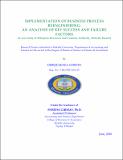| dc.description.abstract | This study of Implementation of Business process reengineering (BPR): an analysis of key
success and failure factors – A Case Study of Ethiopian Revenues and Customs Authority
Mekelle branch is an attempt to explore the effectiveness of the practices in the organization.
Prior studies made on the organization have indicated inefficient organizational structure and
unnecessarily complicated procedures that had permitted insufficient service delivery,
corruption, smuggling and serious tax evasion in the organization. These problems have
depressed the attempt of the organization to be successful in achieving its objectives. To
increase its efficiency, the organization has implemented BPR recently. However, the effect of
the reengineering on quality service, employee satisfaction, and speed has not been so far
investigated.
The major theme of the research was to analyze the key success and failures factors while
implementing BPR in the tax collection procedures, customer service, and employee
satisfaction in the Ethiopian Revenues and Customs Authority Mekelle branch (ERCA). To
attain this objective, the study used descriptive method. Purposive sampling method was used
because it is the best method to collect relevant information from the knowledgeable
individuals willing to provide it. Primary data was the largest portion of information source
and collected from managers, employees and customers. To collect primary data the study
used questionnaire. Discussion was made with management of the organization to obtain key
information. Finally, based on the findings, the organization’s Business process reengineering
(BPR) implementation is just an improvement, not radical change in terms of tax collection
procedures, customer service, employees’ beliefs and cultural change. Using other method of
study, the researcher recommend the researchers to study the impact of Business process
reengineering (BPR) implementation on cost reduction, the impact of Business process
reengineering (BPR) on tax collection performance of the organization and the impact of
Business process reengineering (BPR) in reducing tax evasion and avoidance. | en_GB |


